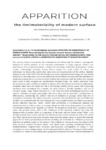‘Reconstituting the Four Quarters: Porcelain Surfaces and Embodied Identities’' ‘Reconstituting the Four Quarters: Porcelain Surfaces and Embodied Identities’ DMU Leicester 3-/-0/20183-/-0/2018
| dc.contributor.author | quinn davis, pete | |
| dc.date.accessioned | 2022-04-27T10:51:11Z | |
| dc.date.available | 2022-04-27T10:51:11Z | |
| dc.date.issued | 2018-03-16 | |
| dc.identifier.uri | http://hdl.handle.net/10026.1/19082 | |
| dc.description | Joint paper with Helen Walter about the Exploring the definitions of ‘heritage’ by considering it from various angles: physical form, artistic formulation, political tool, social and media construct, economic reification and digital innovation. | |
| dc.description.abstract |
The overall context for this work and future work I will undertake; is that the work deals with the political, social and cultural contradictions we face every day. It uses technology both as a philosophical tool to reflect on objects and as a poetic means to document our personal and collective life struggles in the 21st century. The objects themselves, have surfaces, these surfaces have roles, the role of surfaces in this context is their historical contexts, before thinking about how I have worked with these surfaces to decontextualize these objects for a contemporary audience. Created in Plymouth in 1768 or 1769, these figurines were the work of William Cookworthy who, having started his professional life as a chemist, made it his mission to try to create the first truly ‘English’ porcelain in the latter half of the eighteenth century. At this time, there was a sharp distinction between the fine porcelain produced in China using ‘kaolin’ clay, which was called ‘hard paste’ and the imitation ‘China’, which used a different type of clay, and was worked using a ‘soft paste’ method in European centres of production. Cookworthy’s experiments, using a body of clay found in Cornwall that was similar to the kaolin used in Chinese porcelain production, resulted in a successful patent application to produce English porcelain at the founding of the Plymouth Porcelain manufactory in the mid-1760s. | |
| dc.language.iso | en | |
| dc.rights | Attribution-NonCommercial-ShareAlike 4.0 International | |
| dc.rights.uri | http://creativecommons.org/licenses/by-nc-sa/4.0/ | |
| dc.title | ‘Reconstituting the Four Quarters: Porcelain Surfaces and Embodied Identities’' ‘Reconstituting the Four Quarters: Porcelain Surfaces and Embodied Identities’ DMU Leicester 3-/-0/20183-/-0/2018 | |
| dc.type | conference | |
| plymouth.date-start | 2018-03-16 | |
| plymouth.date-finish | 2018-03-16 | |
| plymouth.conference-name | APPARITION THE (IM)MATERIALITY OF MODERN SURFACE ‘ | |
| plymouth.journal | RCA Fashion Research Network | |
| plymouth.organisational-group | /Plymouth | |
| plymouth.organisational-group | /Plymouth/Faculty of Arts, Humanities and Business | |
| plymouth.organisational-group | /Plymouth/Faculty of Arts, Humanities and Business/School of Art, Design and Architecture | |
| plymouth.organisational-group | /Plymouth/REF 2021 Researchers by UoA | |
| plymouth.organisational-group | /Plymouth/REF 2021 Researchers by UoA/UoA32 Art and Design: History, Practice and Theory | |
| plymouth.organisational-group | /Plymouth/Users by role | |
| plymouth.organisational-group | /Plymouth/Users by role/Academics | |
| dc.publisher.place | DMU Liecester | |
| dcterms.dateAccepted | 2018-03-05 | |
| dc.rights.embargoperiod | Not known | |
| rioxxterms.licenseref.uri | http://creativecommons.org/licenses/by-nc-sa/4.0/ | |
| rioxxterms.licenseref.startdate | 2018-03-16 | |
| rioxxterms.type | Conference Paper/Proceeding/Abstract |



